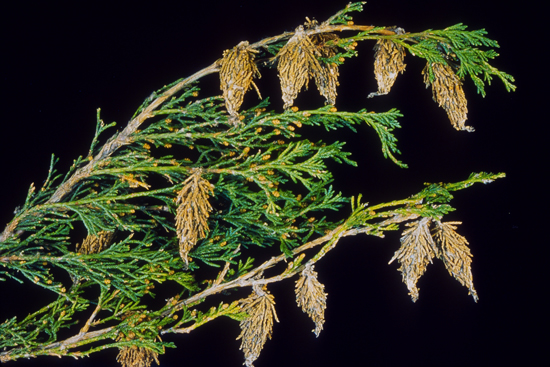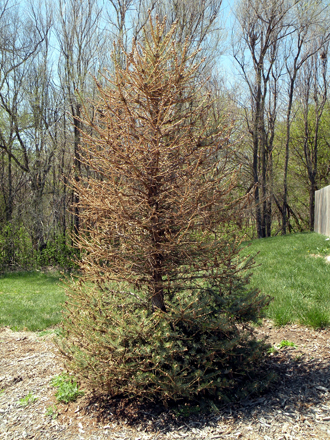G1951
Bagworms
This NebGuide discusses management and control of the bagworm, a feeder on coniferous plants and on many deciduous trees and shrubs.
Frederick P. Baxendale, Extension Entomologist
James A. Kalisch, Extension Associate
The bagworm, Theridopteryx ephemeraeformis, often called the evergreen bagworm, is native to the United States and is generally found in eastern and central Nebraska. Bagworms feed on the foliage of a wide variety of trees and shrubs, but are of most concern on evergreens, especially juniper.
Description and Life History
Bagworms overwinter as eggs within bags fastened to twigs. Eggs hatch in mid-May to early June. Almost immediately after hatching, many of the caterpillars release a streamer of silk and are blown by the wind, establishing new infestations on nearby trees. Others begin to spin tiny (l/8 inch) protective cases or “bags” around themselves. These bags are constructed of silk and fragments of needles or leaves (Figure 1).
 |
| Figure 1. Bagworms on juniper. |
As bagworms grow, leaf fragments are added to bags, which often grow to 2 inches in length by the end of the summer.
Larvae feed until late August or early September. Males emerge in September, usually leaving their pupal cases extending from the bag, and mate with the wingless females through the bag opening.
|
Female moths deposit their eggs within their own bags, drop to the soil, and die. Each female can produce 500 to 1,000 eggs.
Adult males are small, black moths with clear wings. Approximately half the bags on a host plant will contain female bagworms, while the other half contains males. Bags containing males tend to be located closer to the ground on host trees than bags inhabited by female bagworms. There is only one generation per year.
Bagworms follow natural population cycles that may include several years of outbreaks followed by periods of decreased activity. Factors which help regulate bagworm populations include weather patterns and natural enemies such as birds, insect predators, parasitoids, and diseases.
Damage Symptoms
Bagworms feed on most coniferous plants and on many deciduous trees and shrubs. Common evergreen hosts include juniper, arborvitae, spruce, and pine. The earliest signs of bagworm injury in evergreens are brown or stressed needles at the tips of branches. This is caused by the tiny, first-stage bagworm caterpillars etching needle surfaces as they feed. Heavy infestations of older bagworms may completely defoliate a tree or shrub. These plants can be severely stressed or even killed if control measures are not taken (Figure 2). Less severe injury will slow growth and stunt plants. Bagworms are especially damaging to conifers because destroyed foliage is not regenerated.
Bagworms also feed on numerous deciduous shade, orchard, and forest trees, as well as many ornamental shrubs, but heavy infestations are relatively rare. Among the most commonly infested trees in Nebraska are willow, crabapple, honeylocust and bur oak. Since deciduous plants can grow new leaves, damage is usually not serious. The growth of small or newly planted trees, however, can be slowed by bagworm feeding.
Management Strategies
Natural Enemies
Bagworms have a number of natural insect enemies including parasitoid wasps and tachinid flies which feed on and kill bagworms during their larval or pupal stages. A recent study at the University of Illinois at Urbana-Champaign showed that planting asters and daisies near bagworm-infested trees and shrubs in urban landscapes promotes these beneficial insects and reduces bagworm numbers. Flowering plants provide nectar for energy and pollen for egg development in natural enemy populations. If insecticidal control is needed, select reduced-risk products that have minimal impact on these natural insect enemies.
Birds, especially sparrows and finches, are important predators of bagworms in late summer. Promote these birds by planting fruit and seed-bearing plants in the landscape and providing shrubs for roosting.
Mechanical Control
Bagworm infestations on smaller trees and shrubs can be controlled by removing bags during the winter and early spring before egg hatch begins. Destroy bags by crushing or immersing them in soapy water. If bags containing larvae are discarded on the ground, the larvae may return to host plants.
Insecticidal Control
Insecticides are most effective when applied during the early stages of bagworm development. For prevention of early-season damage, apply sprays from late May to mid-June when bags are less than 1/2 inch in length. Insecticidal applications applied later in the summer when bagworms are larger will likely result in much less effective control. By late August, chemical control is no longer feasible, as most bagworms will have ceased feeding and pupated within their bags.
Insecticidal spray applications, whether involving a single tree in the landscape or a shelterbelt, require thorough coverage to penetrate the canopy and make contact with the feeding bagworms. It’s best to use ground equipment capable of delivering higher spray volumes and pressure. Aerial applications may not provide thorough enough coverage, leading to less than satisfactory bagworm control.
Reduced-risk options: Insecticides containing Bacillus thuringiensis (Bt), spinosad, or neem oil (azadirachtin) and insecticidal soaps are quite effective against young bagworm larvae, but may require repeated applications. These products generally have minimal impact on beneficial insects.
Additional insecticide options for bagworm control on ornamental plants include: acephate, bifenthrin, chlorantraniliprole, carbaryl, cyfluthrin, dimethoate, esfenvalerate, fluvalinate, lambda-cyhalothrin, malathion, permethrin, and tebufenozide.
Some pesticide formulations can injure certain plant species. The product label will provide a list of plants (sites) and pests for which it is registered, and in many cases, a list of those plants known to be injured by the product. When making an application, be certain the product is specifically labeled for both the target pest and plant species.
Caution: Use all insecticides with caution to avoid exposure to humans, pets, wildlife, and other non-target organisms. Always read, understand, and follow label directions. Store all pesticides in original labeled containers out of reach of children.
This publication has been peer reviewed.
Visit the University of Nebraska–Lincoln Extension Publications Web site for more publications.
Index: Insects & Pests
Ornamentals and Trees
Issued May 2009
